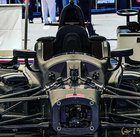|
The term Monocoque is a structural design whereby stresses are applied to the outer skin, rather than using an internal structure such as ribs and cross beams. It's a bit like an egg really. It’s a French name for ‘single shell’. French Aeroplane builders had a desire to build a stressed skin that was light and strong, that would need little internal structure. To make an enclosed aeroplane fuselage was a relatively simple design task as all the surface is complete with no holes. For a racing car however, once you create a cut out for the driver to sit in, it becomes much more challenging, as much of your rigidity has suddenly disappeared and naturally would want to fold in on itself, which means you have to use extremely tough materials. This is where Carbon fibre plays its trump card, as it's essentially one piece, there are fewer stress points, unlike a typical aluminium Monocoque where you have rivets and welds. This means you can create an open top monocoque and keep the high strength that’s required, as well as mounting suspension pick up points that can withstand extremely high loads. The strength of a composite Monocoque chassis becomes only apparent once there is a big high-speed shunt where everyone still holds their breath, and drivers still walk away. These are now commonly referred to as safety cells in series such as F1 and Indy cars, this also becoming their primary objective in the design process. The priority of safety doesn’t stop there, by altering the construction of these carbon structures, designers continue their work with crumple zones around the Monocoque Safety Cell. Such areas are not completely obvious such as a nose cone, where underneath the glamourous paintwork is a cleverly disguised tapered crash structure, with alternating fibre directions which deforms progressively to absorb the energy from a heavy impact. submitted by /u/Motorworx_ |
Click Here to Read the Full Original Article at Motorsports…

